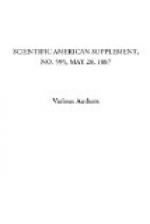Again, to use a homely phrase, “You cannot eat your cake and have it.” You cannot have a large quantity of blue rays present in your direct sunlight and have a luminous blue sky. The latter must always be light scattered from the former. Now, in the high Alps you have, on clear day, a deep blue-black sky, very different indeed from the blue sky of Italy or of England; and as it is the sky which is the chief agent in lighting up the shadows, not only in those regions do we have dark shadows on account of no intervening—what I will call—mist, but because the sky itself is so little luminous. In an artistic point of view this is important. The warmth of an English landscape in sunlight is due to the highest lights being yellowish, and to the shadows being bluish from the sky light illuminating them. In the high Alps the high lights are colder, being bluer, and the shadows are dark, and chiefly illuminated by reflected direct sunlight. Those who have traveled abroad will know what the effect is. A painting in the Alps, at any high elevation, is rarely pleasing, although it may be true to nature. It looks cold, and somewhat harsh and blue.
In London we are often favored with easterly winds, and these, unpleasant in other ways, are also destructive of that portion of the sunlight which is the most chemically active on living organisms. The sunlight composition of a July day may, by the prevalence of an easterly wind, be reduced to that of a November day, as I have proved by actual measurement. In this case it is not the water particles which act as scatterers, but the carbon particles from the smoke.
Knowing, then, the cause of the change in the color of sunlight, we can make an artificial sunset, in which we have an imitation light passing through increasing thicknesses of air largely charged with water particles. [The image of a circular diaphragm placed in front of the electric light was thrown on the screen in imitation of the sun, and a cell containing hyposulphite of soda placed in the beam. Hydrochloric acid was then added; as the fine particles of sulphur were formed, the disk of light assumed a yellow tint, and as the decomposition of the hyposulphite progressed, it assumed an orange and finally a deep red tint.] With this experiment I terminate my lecture, hoping that in some degree I have answered the question I propounded at the outset—why the sun is red when seen through a fog.
* * * * *
THE WAVE THEORY OF SOUND CONSIDERED.
By HENRY. A. MOTT, Ph.D., LL.D.
Before presenting any of the numerous difficulties in the way of accepting the wave theory of sound as correct, it will be best to briefly represent its teachings, so that the reader will see that the writer is perfectly familiar with the same.




